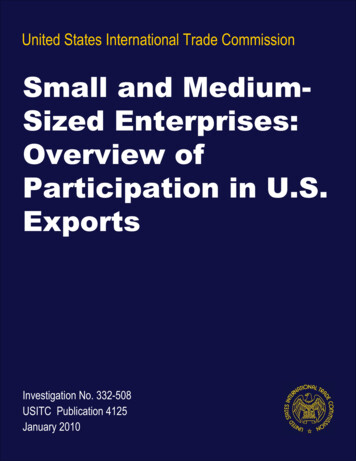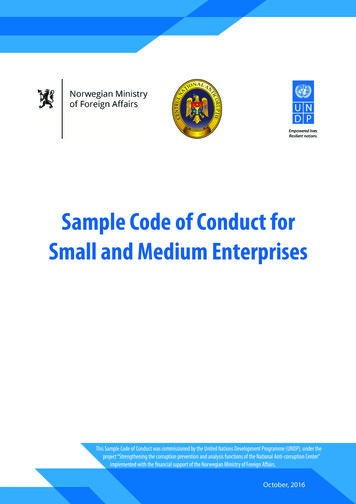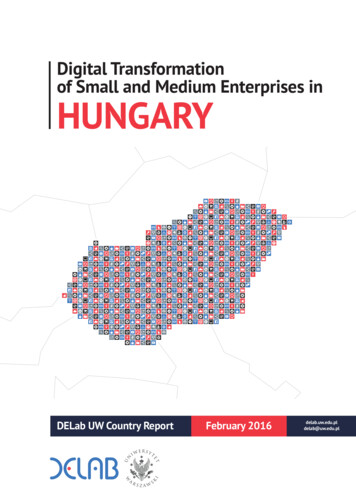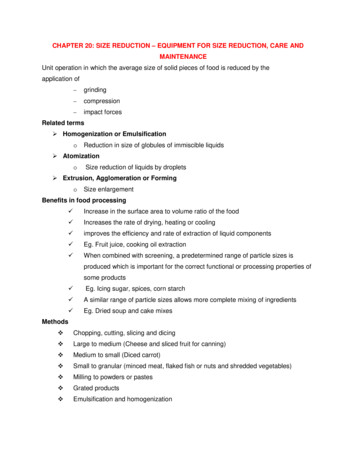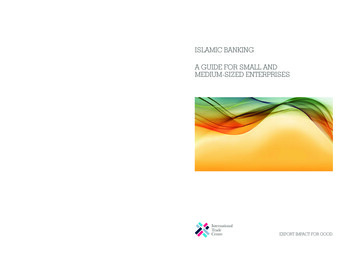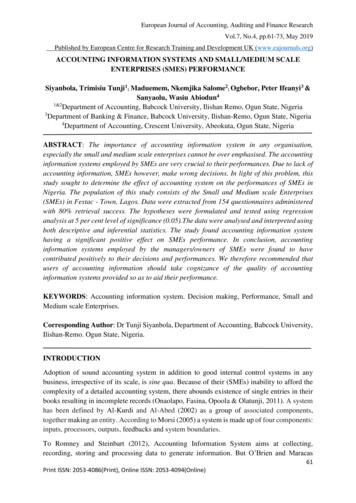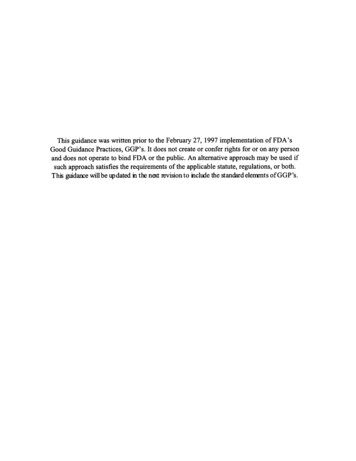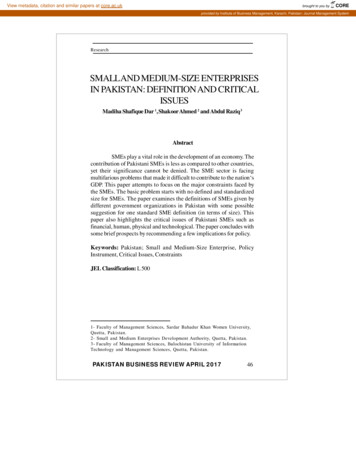
Transcription
View metadata, citation and similar papers at core.ac.ukbrought to you byCOREprovided by Institute of Business Management, Karachi, Pakistan: Journal Management SystemResearchSmall and Medium-Size EnterprisesResearchSMALLAND MEDIUM-SIZE ENTERPRISESIN PAKISTAN: DEFINITION AND CRITICALISSUESMadiha Shafique Dar 1, Shakoor Ahmed 2 and Abdul Raziq 3AbstractSMEs play a vital role in the development of an economy. Thecontribution of Pakistani SMEs is less as compared to other countries,yet their significance cannot be denied. The SME sector is facingmultifarious problems that made it difficult to contribute to the nation‘sGDP. This paper attempts to focus on the major constraints faced bythe SMEs. The basic problem starts with no defined and standardizedsize for SMEs. The paper examines the definitions of SMEs given bydifferent government organizations in Pakistan with some possiblesuggestion for one standard SME definition (in terms of size). Thispaper also highlights the critical issues of Pakistani SMEs such asfinancial, human, physical and technological. The paper concludes withsome brief prospects by recommending a few implications for policy.Keywords: Pakistan; Small and Medium-Size Enterprise, PolicyInstrument, Critical Issues, ConstraintsJEL Classification: L 5001- Faculty of Management Sciences, Sardar Bahadur Khan Women University,Quetta, Pakistan.2- Small and Medium Enterprises Development Authority, Quetta, Pakistan.3- Faculty of Management Sciences, Balochistan University of InformationTechnology and Management Sciences, Quetta, Pakistan.PAKISTAN BUSINESS REVIEW APRIL 201746
ResearchSmall and Medium-Size EnterprisesIntroductionSmall and medium-size enterprises (SMEs) play a significantrole in the economic, industrial and social development of a country.According to Rohra and Panhwar (2009), most of the developedcountries concede the importance of SME sector in assisting theireconomies. SMEs play a distinctive role in the development, as it hasbeen a source of employment creation and income generation. Thesecontribute in the development of a nation in maintaining the standardof life by increasing the income of the people. SMEs have a majorcontribution in the development and competitiveness of the economy(Minniti, Bygrave &Autio, 2005; Hodgetts &Kuratko, 2004 ;Schlogl,2004; Ahmad, Rani &Kassim, 2011).SMEs in Pakistan play a critical role in the economic growth,progression of technological innovation, sourcing to large industries,cottage industries and promoting economic renewal and socialdevelopment. SMEs are one of the main sources to reduce poverty,expand national economy. It can be the foundation of employmentand social uplifting. Pakistan’s economy, like that of many developingcountries is a direct reflection of its SME sector (Khalique, Isa, &Nassir Shaari, 2011). According to Economic Census of Pakistan2005 (this is the latest census in Pakistan), there are 3.2 millionbusinesses in Pakistan. SMEs represent more than ninety percent ofall private businesses and employ nearly 78 percent of the nonagriculture labor force in Pakistan (PBS, 2011). SMEs’ contribution toPakistan’s Gross Domestic Product is more than 30%. Additionally,the sector represents 25% of exports of manufactured goods and35% in manufacturing value added. Almost 53% of all SME activity isin retail trade, wholesale, restaurants and the hotel sector. As regarded20% of SME activity is in industrial establishments and 22 % in serviceprovision (PBS, 2011).Recognizing the significant contribution ofSMEs to economic diversification, employment creation, incomegeneration, and poverty alleviation, the Government of Pakistan (GoP)has been putting much effort and resources towards the promotionof the development of entrepreneurship and SMEs in general. Forexample, the GoP established a Small and Medium EnterpriseDevelopment Authority (SMEDA) in October 1998 with the aim ofdeveloping this sector. The GoP has also established an SME and47PAKISTAN BUSINESS REVIEW APRIL 2017
Small and Medium-Size EnterprisesResearchmicro finance banks to finance this sector. Moreover, as per thedirections of GoP, most commercial banks in the country havespecialized departments for the SME sector (Bhutta, Arif, & Usman,2008). However, regardless of their economic importance, SMEs inPakistan suffer from a variety of shortcomings, which have confinedtheir ability to adjust to the economic liberalization measuresintroduced by the GoP and their capacity to take full advantage of therapidly growing world markets. These shortcomings include, forexample, focus on low value-added products, absence of an effectivebusiness information infrastructure, energy crisis, lack of strategicplanning, low levels of financial literacy, unskilled human resourcesand non-aggressive lending strategies by banks (Bari, Cheema, &Ehsan-ul-Haque, 2005; Khawaja, 2006; Mustafa & Khan, 2005; Rohra& Panhwar, 2009; SBP, 2010).Background of the study: The fundamental theme of thispaper is to emphasize that there exists no standard definition of SMEsand how it can be a drawback in the progression of economy. Pakistaneconomy is an economy of SMEs. They constitutes the bulk ofPakistan‘s business landscape. Nothing portrays the reality of Pakistanibusiness environment better than the nature of its SME sector.Therefore, it is significant to clearly identify different categories ofSMEs and takes into account various types of enterprises (even smalllocal enterprises or partnerships) under one definite definition.Previously there has been lengthy debates and arguments regardingthe major thresholds in the definition of SMEs (Soomro & Aziz, 2015).Many countries across the world have struggled over to determineappropriate size of SMEs and also to overcome the challenges thatimpede the progress of SMEs (Kushnir, Mirmulstein & Ramalho, 2010).Economist, practitioners and academicians verified that SMEs are foundto elevate growth (Khan & Ali Qureshi, 2007), create employment,reduce poverty (Ali, 2013) and alleviate foreign exchange earnings(Berry, Aftab & Qureshi, 1998; Soomro & Aziz, 2015).Since the establishment of SMEs Pakistani Government isneglecting their importance and not facilitating them to handle crisis(Haque, 2007). However, there is tremendous potential in PakistaniSMEs that can be tapped. Therefore, this require a genuine support ofgovernment, private and public officials to facilitate the new definitionof SMEs as its predicted to be immensely productive and act as aPAKISTAN BUSINESS REVIEW APRIL 201748
ResearchSmall and Medium-Size Enterprisescatalyst for economic growth and development (Khan & Ali Qureshi,2007). The practitioners and academics acknowledge it with itsnumerous advantages. Hence, it is significantly important to adjustnumber of employees, value of total assets, sales up turnover andpaid up capital, (Soomro & Aziz, 2015), as with standard definitioninternational markets will easily be penetrated and Pakistani SMEscould more be waved in this era of globalization (Phore, & Shaikh,2010). This will promote innovation and foster research anddevelopment. It will also help to improve access to capital as itfacilities equity financing for SMEs and concluded to be a nationaleconomic growth engine (Ejaz, 2012). If foremost challenges areundertaken SMEs stimulates the economic growth and developmentof Pakistan.Objective of the study: The focus of this study is to examinethe definitions of SMEs given by different Government organizationsin Pakistan with some possible suggestion for one standard SMEdefinition. This paper also highlights the critical issues of PakistaniSMEs such as financial, human, physical and technological.MethodologyThe criterion used in the paper was based on literature thatclassifies the definition and critical issues of SMEs. The studies werechosen based on highly reputable journals to ensure quality andfrequency of studies (see for example S. Pansiri, J., & Temtime, Z. T.,2004; Bari, F., Cheema, A., & Ehasan ul Haq, 2005; Dasanayaka,2008;Mahmood, et al., 2011; Moghal, S. & Pfau W.D., 2014). Severalconference papers and report writings were also the source of literature.Only those studies have been included that cover the details aboutSMEs as the focus was on assessing the definition of SMEs (in termsof size) and examining its critical issues. The literature select from1995 onwards stipulate the definition of SMEs. The selection ofliterature for critical issues was restricted to studies from 2001 andonwards with the studies including major constraint, issues andproblems.Accessing appropriate data has been critical but a systematicapproach was adopted to identify and assemble relevant sources ofdata. Researchers examined the main criteria used for defining SMEs49PAKISTAN BUSINESS REVIEW APRIL 2017
Small and Medium-Size EnterprisesResearchand proposed a judgmental definition in contrast to the existingdefinitions of SMEs. The analytical methodology encounters theevaluation of unstructured interviews that are conducted within thedomains of SMEs. Based on the interviews of practitioners andacademicians a balance scorecard approach is envisaged. Thisproposed technique is recommended to eradicate the major constraintsthat hinder the progress and growth of SMEs.Definition of SMEsDefinitions of SMEs in Other Countries: The SME definitionsapplied in various countries are based upon various criteria such asnumber of employees, value of assets, sales and volume of output(Cunningham & Rowley, 2008). These definitions vary from countryto country and also within countries. For instance, France defines aSME as having less than 500 employees; whereas Germany uses lessthan 100 employees (see Table 1).Moreover, within countries,definitions may also vary by sector or type of business. For instancein Japan, manufacturing, mining, and transportation and constructionindustries defines a SME as having less than 300 employees or investedcapitalization less than 100 million yen. While wholesale businessesdefine a SME as an organization employing less than 100 employeesor capitalization less than 30 million yen. In retail it is defined asbusinesses employing less than 50 employees or capitalization lessthan 10 million yen (see Table 1).Defining SMEs within the Pakistani Context: There is nouniform definition of SMEs in Pakistan (Dasanayaka, 2008;Mustafa &Khan,2005;Rana, Khan& Asad, 2007). The SME Bank, SMEDA,Pakistan Bureau of Statistics (PBS) and State Bank of Pakistan (SBP)have defined SMEs in different ways. Under fifth schedule toCompanies Ordinance 2015, Securities and Exchange Commission ofPakistan (SECP) also classified large, medium and small companiesexclusively. For example, SMEDA defines a SME based upon thenumber of employees and total number of productive assets. TheSME bank uses only total number of assets as the criterion. PBS takesinto consideration only the number of employees. Whereas, SBP’sdefinition of a SME is based on the nature of the business, number ofPAKISTAN BUSINESS REVIEW APRIL 201750
ResearchSmall and Medium-Size EnterprisesTable 1:Definitions of SMEs in International Countries1CountryCanadaFranceGermanyHong y typesSMESMESMEManufacturingSMESMESmall nstructionWhole sale ited StatesVietnamMisSmall enterprisesMedium enterprisesSmall enterprisesManufacturingServicesSmall enterprisesMedium on industriesService industriesLaboursectorsCapitalsectorsSMEDefinition of SMEsIndependent firms having less than 200 employees 500 employees 100 employees 50 employees 100 employees 500 employees 200 employees 300 employees or invested capital less than10 million yen 100 employees or capitalization less than 30 million yen 50 employees or capitalization less than 10 million 300 employees 300 employees construction 200 employees commerce and other service business; 20employees 75 full time workers or with a shareholder fund of RM 2.5million (US 1 million)Manufacturing establish ments employing between 5 and 50employees or with a shareholders fund up to RM 500,000Manufacturing establishments 10 employees10-100 employees 200 employees, revenue P 40 millionFixed assets S 15 million 200 employees and fixed assets S 15 million 200 employees 500 employeesAutonomous fir ms with 200 employeesNo fixed definition NT 60 million of sale volume and 200 employeesintensive NT 80 million of sale volume 50 employees 200 employeesintensive 100 employeesVery small enterprisesSmall enterprisesMedium enterprisesSMENo fixed definition 20 employees20-99 employees100- 499 employeesNo fixed definition, generally 200 employees1-Source: (Adopted from Cunningham & Rowley, 2008, pp. 355-356)51PAKISTAN BUSINESS REVIEW APRIL 2017
ResearchSmall and Medium-Size Enterprisesemployees, amount of capital employed and net sales value per annum.The details of these definitions are presented in Table 2.Table 2:Definition of SMEs in Pakistan2Institution in ty (SMEDA)SME BankFederal Bureau ofStatisticsState Bank ofPakistanSecurities and ExchangeCommission ofPakistanCriterionNo. of employees( 250 employeesMedium ScaleBetween 36-99forSmall ScaleBetween 10-35Productive Assets20 -40 million PKR2-20 million PKRTotal AssetsNo. of EmployeesOver100million PKRN/ALess than 100 millionLess than 10 employeesNature of Business(ManufacturingTrade/Services)No. of employeesCapital employedNet sale valueLess than 250 employees andless than 100 million PKRassets for manufacturing.Less than 50 employees andless than50 million PKR fortrade/services.Net sales less than 300 millionPKRCompany which has annualA non listed company which isgross revenue ( grants,not a :income.a) PublicInterestSubsidies,donations)Company; orincludingb) Large sized CompanyOther income/revenueorless than Rs.200 million.c) Small Sized Companyother than a non-listedpublic companyLess than 250 employees andless than 100 million PKRassets for manufacturing.Less than 50 employees andless than 50 million PKR fortrade/services.Net sales less than 300million PKROther than a non-listed publiccompany:a) Paid up capital notexceeding Rs. 25million, andb) TurnovernotexceedingRs.100million.The definition of SMEs in Pakistan lies on the number ofemployees up to 250 people, paid-up capital up to Rs.25 million andannual sales up to Rs.250 million (Kureshi et al., 2009).This definitionwas an outcome of a consultative process of spanning over two yearsfollowed by scrutiny and refining at various levels of governmentbefore its finalization and approval by the Federal Cabinet in 2007(SMEDA, 2007). Generally one of the imperfections in the definition isthe absence of segregating line between Small and Medium and amongManufacturing, Trade and Service sectors. Therefore, the definitionof SMEs could not be finalized. Moreover, the implementation hasalso been remained a critical issue. This has been discussed in thenext section of the article. Despite this definition, SMEs are defineddifferently by other institutes such as PBS and SBP. The institutesconform to their own definition and understanding of SMEs. One2-Source: (Adopted from Dasanayaka, 2008, p. 71 ; SMEDA, 2011 )PAKISTAN BUSINESS REVIEW APRIL 201752
ResearchSmall and Medium-Size Enterprisesdefinition lodged by SBP refers SME as the SME can be categorizedinto three classes, micro, small, and medium enterprises (State Bankof Pakistan, 2010). SBP characterize SME as, “any private economicestablishment engaged in manufacturing, trading or service providingbusiness with net annual turnover or sales up to Rs.300 million in thecurrent fiscal year; or any manufacturing entity having total assetsup to Rs.100 million excluding land and buildings with maximum 250employees or any trading or service concerning total assets up toRs.50 million excluding land, buildings and with maximum 50employees.”In the context of Pakistan, no uniform and standarddefinition of SMEs has been available that effected the progress andsuccess of the SMEs. The Government of Pakistan and political regimeshave failed to establish a synchronized definition for SMEs. . Aharmonized definition considering micro, small, medium and largeenterprises will help to launch a sound mechanism for the developmentof SMEs. Therefore, keeping in view, as a practicing manager andacademicians a proposed definition is comprehended below that ispredicted to benefit Pakistan economy and also be recognizedinternationally.Proposed SME definitionCriterionNo. of emplo yeesMedium ScaleBetween 25-99Small ScaleBetween 5-24Productive Assets10-40 million PKR0.5-10 million PKRTotal AssetsOver 50 million PKRLess than 50 millionProposed definitionRecommendations to establish a harmonious definition:The established definition should be applicable and ofappropriate size and attributes. It should be establish on standardcriteria after analyzing market failures and practical constraints. Inorder to develop a single definition that could be applied across theeconomy is to target the needs and goals that an enterprise is goingto fulfill. The definition should be based on the needs and goals ofthe policy established. When a single definition will prevail throughoutthe country this will help to distinct the enterprises and the associatedproblems will be minimized. The need is to target the policy goals andobjectives effective. The definition should be developed in ways thataccomplish not only the national objectives but also the internationalperspective. The definition in this manner will be accepted53PAKISTAN BUSINESS REVIEW APRIL 2017
Small and Medium-Size EnterprisesResearchinternationally which will help to enhance the business boundaries.At present SMEs definitions are based on different criteria that maylead to market failure. SMEs definition should be coherent, visibleand stable. The framework and structure within which the SMEdefinition operates should be stable and well formulated. Thedevelopment of a clear definition will give a way of avoidinginconsistencies and distortion between the enterprises. The definitionshould provide a stable framework that does not require any majorchanges and if the changes are to be made that will be minuteadjustments relating to inflation, rules of investment or any otherregulations governing the enterprises.In order to devise a formal andstandard definition the organizations should collect appropriate dataconsistently and efficiently and keep on revising the definition as perthe requirements and needs. The definition should be applicableaccording to the role and regulation. The policy measures should besupported by the definition. A pragmatic and relevant definition willhelp to balance the economic growth as well as market economy. Thedefinition of SME acts as a policy instrument. It should be definedwithin the frame work of policies of other countries like EuropeanUnion (EU) policy to match and also be up to the international standard.The definition should not be extended beyond 250 employees andshould continue to be the main instrument of competitive policy. Itwill help to provide effective and efficient assistance to SMEs. Pakistanshould establish a definition that benefit its economy and that shouldalso be recognized internationally.SMEs are called to be born global firms and the definitionshould provide a stable framework, which may need some modificationin certain areas, including an eventual adjustment for inflation andproductivity changes, and also some further clarification. It’s essentialprimarily needs to be developed further in its applications, including agreater use of existing distinctions with the definition.SME definitionhas to be elaborated more and should be detailed for the properapplication and implication. This ensures that an appropriate data isto be collected consistently and efficiently. It will help competingmarkets and enhance the performance. It will be easy to regulate andarticulate with clear and proportionate procedures. Precise regulationand administrative measures will be developing by a stable and uniformdefinition. It is recommended that to assist the monitoring of theapplication of the SME definition, there should be a central register ofPAKISTAN BUSINESS REVIEW APRIL 201754
ResearchSmall and Medium-Size Enterpriseslegislation and policy instruments making reference to the SMEdefinition.Critical Issues of SMEs in PakistanPakistan has amazing potential of development to boost upthe economy and standard of living of its people. However, the keyproblems or challenges slow down the progress of SMEs. The SMEshave been neglected till late 90sand the main focus remained oncorporate sectors particularly in large scale manufacturing units.Government, banks and financial institutes emphasized more on thelarge sector than on SMEs. Khawaja S. (2006) unleashed in his articlethat “according to the regulatory and policy environment of Pakistanis not very conducive for the growth of SMEs sector and overallgovernment effort is remained concentrate for the development oflarge firms.” It has been since long that SMEs do not get adequateaccess of resources and the focus concentrated on large industrialscale. The strength and success of SMEs exist in innovation, uniqueskills, good network, quick communication, less bureaucracy, closeexternal and internal contacts, market trends and flow. According toother group of scholars the success of SMEs is influenced byknowledge, experience and skills of the employees and owner. Lackof tangible resources such as physical and financial capitals are criticalfor a SMEs progress whereas intangible resources when utilizeproperly are significant for the growth. Getting access to finance isone of the biggest challenges for SMEs and a major portion of SMEsdo not have the security needed for collateral, without which thesanction of a loan from banks and lending institutes appears verydifficult. Most of the SMEs appear deficient in accounting and financialinformation that hinders them to avail information-based or financialstatement-based lending and respective credit scoring. The majorityrelies on the personal finances, credit from suppliers, loans from friendsand relatives. Banks role is limited as taxes, corruption, high interestsand prices are the main grievances. As uncovered the main problemof SMEs is that it does not have access to formal sources of financing(including banks and lending institutions). According to SBP reportthere was an overall decline in SME financing that fall 20% to Rs.348billion in 2009, from Rs.437 billion in 2007.Following SBP quarterlyreport, 2015 identified that SME financing has dwindled to 5.8 percentof the total financing as compared to 6.3 percent in the previous55PAKISTAN BUSINESS REVIEW APRIL 2017
ResearchSmall and Medium-Size Enterprisesquarters (Ahmed, 2015).The consequences of the decline were foundto be loan defaults and slowing economy (State Bank of Pakistan,2010). Gallup Pakistan 2006 also revealed top ten problems emergingout of which lack of finance is the first problem. It was also revealedthat 89% of the loan disbursements by SMEs were for working capitalrequirement. That reflected Pakistani banks were reluctant forsupplying long-run financing and project financing for initial SMEsset ups. Table 3 throws light on the major strength, weakness,opportunities and threats of Pakistani SMEs.Table 3:SWOT Analysis of Pakistani SMEs1Wea kness Financial constraints Access to strong financial resources High labor cost Lack of skilled human resourcesManagement Many years of personal experience of running own Lack of managerial educationbusiness Entrepreneurial mindset High motivatio n in developing the business Creating friendly environment in the firmMarketing Access to effective advertising tools Poor marketing information/ managementTechnology Unique position ,experience and technical skill Lack of inab ility to adapt new technology(IT skills, sports and surgical equip ments)Structure Flexible and entrepreneurial organizational structureOpportunitiesThreats Innovation and intellectual property rights Customer demand shifts away from the firms(Pakistani SMEs are exporting surgical, sportpro ducts or servicesequipments( because of price war)And textile products, this can be protect their brand) Opportunity of franchise and Entry of multinational and more powerfulJoint venture with other organizations.competitor into the local marketResourcesStrengths Strong family support High rate of profitability Local distrib ution chan nels (supply chain) Government is building special industrial zonesto help the businesses flourish SMEs can build their reputatio n throughgetting quality certificates 1Infrastructure constraints, lack of properinfrastructure is a major barrier for SMEs(Powersupp ly,Roads,Poorcommunication System)Lack of standardization, InternationalQuality Certificates to certify the quality ofservicesSource: Prefeasibility Report of SMEDA.Focusing on SMEs Work Progress Report, it has beenidentified that it has had a mixed bag of achievements. Its excellentperformance of five years in the beginning has slowed. The criticalissues that slow down the progress of SMEs are the changes in politicsregimes, legislation and the allocation of taxation procedures prevailingin the country. The other stated issues are highlighted as shortage ofskilled workers, lack of business opportunities, corruption, lack ofknowledge, government interference, procurement of quality rawmaterial, registration and license for work, adaptation and knowledgePAKISTAN BUSINESS REVIEW APRIL 201756
ResearchSmall and Medium-Size Enterprisesof new technology, orders and marketing of product (Gallup Pakistan2004). Other identified constraints include the scarcity of capitalgoods, lack of resources and data. Resistance to change and unskilledworkers/labors are one of the other causes of SMEs failures. Lack ofknowledge and technology has made the working difficult. SMEsneed to be more aware of the importance and applications of intellectualcapital. Intellectual capital has become an important determinant ofcompetitive advantages (Chen et al., 2006).SMEs failed to develop as they didn’t received any economicand government support. It has not taken as priority and not muchattention. SMEs have faced insufficient funds, low technologicalcapabilities, outdated production facilities, non-competitive productsand shortage of trained manpower. SMEs are facing low growth,trapped with old products and are unable to climb up the technologicalladder (Khawaja, 2006).Other obstacles include lack of business plans,viability reports that are useful in assessing the business (cash flowstatements, balance sheets, return on investment etc). Lack ofinformation on accounting, managerial, marketing and other technicalskills are the issues that should be addressed properly. Focus onquality, adoption of standardized processes and procedures inconformity with standard operating procedures are always tough toattain. The obtaining of standardized certificates is also one of thebasic constraints that should be overcome. Raw material, power, landtransport and technical facilities are the constraints that make itdifficult for SMEs to contribute to a nation‘s GDP as expected. Thetable in appendix illustrates the major critical issues. The authorshave discussed these issues in detail in their article in correspondingyear.Proposed approach to eradicate SMEs barriers: Theresearchers (Kaplan and Norton1992, 1996; Hudson, Smart, & Bourne,2001) explained that organizations need new capacities and capabilitiesfor competitive and economic success, e.g. product innovation,customer relations, customized products, employee motivation andskills and usage of information technology. The Balance Scorecardhas four perspectives, which are internal process, financial, customerand learning and growth/ development.57PAKISTAN BUSINESS REVIEW APRIL 2017
Small and Medium-Size EnterprisesResearchThe paper implied Balance Scorecard that helps to eliminatethe critical problems and barriers. Research proved that theseconstraints impede the progress and growth of SMEs (). Hence, theobjective of Balanced Scorecard is to remove the constraints of SMEsgrowth in Pakistan and help them to grow. The four differentperspective of Balance Scorecard are discussed and also representeddiagrammatically (figure 1).Internal Process: According to the interview analysis, mostof the SMEs emphasized that government uncertain policies are themain and important barrier in SMEs growth. The study suggests thatif Government of Pakistan has consistent and encouraging policieson SMEs, this could create a favorable environment for the growth ofSMEs and their growth can help in employment creation and boostthe Pakistani economy. In this perspective, the Government of Pakistanconsistent and beneficial regulatory policies regarding SMEs couldhelp the SMEs to make erudite decisions regarding their business.According to SMEDA (2010) report there is no such policy for SMEsin Pakistan, which can benefit them, expect approval of SME policy2007.Most SMEs strongly complained about the misbehavior anddisruptions created by government officials due to unnecessary andexcessive regulations and the problem of effective governmentemployees and corruption issues, the grievances were largely fromthe behavior of income tax department and miserable attitude ofgovernment agencies created to support the SMEs in Pakistan. Onthe other side, the law and order situation of Pakistan is unpleasantdue to the terrorism. This is one of the biggest challenges facedtoday which affected SMEs badly an
Pakistan’s Gross Domestic Product is more than 30%. Additionally, the sector represents 25% of exports of manufactured goods and 35% in manufacturing value added. Almost 53% of all SME activity is in retail trade, wholesale, restaurants and the hotel sector. As regarded 20% of SME act
